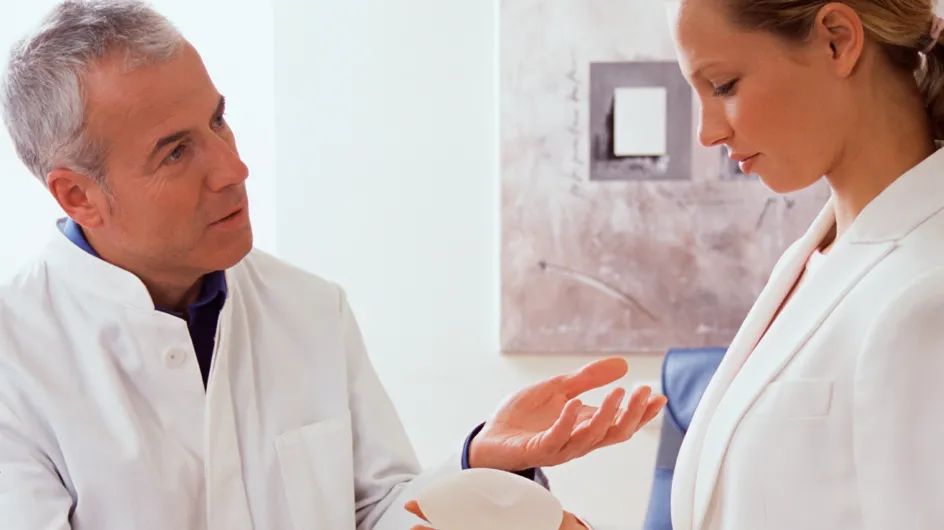It's no surprise that breast augmentation is the most common cosmetic surgery carried out in the UK. Too small, too big, not pert enough, not round enough, it sounds a lot like us ladies are never happy with our bosoms however much we stuff our bras with chicken fillets.
For those women thinking of having cosmetic surgery to get their dream cleavage here's some professional step by step advice. From the initial consultation to what happens during the procedure and after care, we spoke to Consultant Plastic Surgeon Professor Simon Kay to find out everything you need to know about a typical breast augmentation procedure.
What happens at the consultation stage?
During the consultation the surgeon should take a medical history, examine the patient and establish that they are suitable for surgery. This is not always the case and it is the duty of the surgeon to advise the patient professionally in their best interest.
The surgeon will also recommend the most suitable procedure for the patient, it is common for patients to ask for breast implants when inspection of their breasts reveals that they would also benefit from a breast lift of some form or other. The patient is also fully informed about the proposed surgery including what the procedure involves, the aftercare required, the risks and potential complications that can arise and how they would be managed.
What steps happen between the consultation and deciding to have the surgical procedure?
Following the consultation it is good practice for the surgeon to provide the patient with written information that the patient can read and absorb at their own pace. The patient should also have a cooling off period and an opportunity to return to discuss the details of the procedure.
I try to encourage patients to bring with them a friend or relative who can listen and absorb the information and ask questions. At the end of this process only patients who are well-informed and for whom surgery is likely to reverse their symptoms should be going forward to surgery, confident that they understand what is to happen and the potential risks and benefits.
What preparation do you have to go through before the operation?
Surgery and general anaesthesia is safe in the current era but it is wise to be as fit as you can, to eat healthily, to exercise regularly and not to smoke. Some hospitals will require a pre-assessment by a nurse but most patients undergoing breast enlargement are young and healthy so this is not always the case.
What happens before the surgery?
Prior to surgery the patient is admitted through the normal admissions procedure of the hospital, seen and examined and prepared for surgery. They will meet the surgeon again and a consent form signed. This is purely to acknowledge that the patient feels (and is) fully informed and you should not sign this form if you do not feel the preparation has been adequate. Usually photographs will be taken and the patient will have an opportunity to ask any further questions.
On the day
What should you bring with you on the day?
Each hospital will give specific instructions in their admission advice as to what to bring with you.
Where is the anaesthesia administered? How long does it take to work?
Most patients will have a pre-medication on the ward and then the anaesthesia is administered in an anaesthetic room immediately adjacent to the operating theatre.
How long does the operation last for?
The operation lasts for as long as is necessary in order to obtain the right appearance of the breast but usually this is in the region of one to two hours .
What happens during the operation? Step by step
During the operation, after the patient is suitably cleaned, prepared and the operative field made sterile, the surgeon will make an incision which in the UK is usually placed in the fold beneath the breast. Through that incision he or she will open a pocket either in front of the muscle or behind the muscle (the placement behind or in front of the muscle depends on many factors including how thin the patient is, how much breast tissue there is to start with and the nature of the implant chosen).
Having created that pocket and prevented any bleeding the surgeon will trial different profile sizes and shapes of implant as required or as discussed with the patient prior to surgery. When he or she feels that the appropriate size (guided by the sizing exercise prior to surgery) has been selected and that a pleasing and appropriate shape commensurate with the patient’s expressed wishes has been achieved the final implant is selected and placed. The wound is then closed in layers and usually a surgical drain tube is not required. Normally the wound closure is with an absorbable suture both internally and in the skin, and these do not need to be removed.
How is the area bandaged?
All surgeons have their own preferences for postoperative bandaging of the breast and many choose some form of either conforming dressing or compression, either with tape or elasticated bandage or a specially designed breast band.
How is infection prevented?
Infection at the time of surgery is prevented by meticulously sterile conditions but also it is normal for a patient to have one dose of antibiotic administered at the time of surgery.
What pain killers are used post op?
Very rarely is any significant pain relief required as this is not normally a painful procedure requiring more than paracetamol or anti-inflammatory drugs.
Post surgery
How long do you stay in hospital/clinic for?
Whilst it is possible to return home immediately after surgery many surgeons (myself included) prefer the patient to remain in hospital overnight in order to reduce movement, encourage rest and therefore prevent bleeding and swelling.
When can you remove the dressing?
Each surgeon and their nursing team will advise the patient on dressing care which will be specific to the type of dressing chosen by that surgeon.
What activities should you avoid post-op?
My patients are advised to avoid impact sports such as running, jogging etc for the first three weeks and for the first week I like them to avoid all physical exercise other than gentle walking.
What can you wear to support the area post operation?
Each surgeon will advise the patient when to move from an elasticated support to their own bra, which is usually a soft sports bra in the first instance.
What kinds of symptoms are normal and abnormal post op?
Normal symptoms include swelling, some discomfort which is normally manageable by minor pain killers alone, and some prickling or shooting pains.. Abnormal symptoms include increasing swelling, increasing pain or fever and redness and these should alert you to return immediately to your surgeon.
What advice would you give to anybody about the procedure?
My advice on breast augmentation is that it is a safe operation and that breast implants have been very extensively studied in many countries in many ways in large trials since the nineteen eighties. No definite adverse effect on health has been identified and I am confident that they represent a safe option for improving the size, shape and appearance of breasts in the appropriate circumstances.
It is not a one size fits all operation and like all surgery, it has risks and potentials for complications which should be discussed carefully with the surgeon and his or her team. In an appropriately equipped safe hospital with an appropriately qualified Plastic Surgeon or Specialist Breast Surgeon this is a safe procedure that can be not just breast enhancing but life enhancing.
However you must be confident in your surgeon and confident that you have been well-informed, and understand the potential risks and complications as well as the potential for adverse outcomes such as irregularities in the implant, rippling, hardening of the implant, loss of sensitivity in the nipple and the risk of infection and the need for future revision of the implants (which have a fixed lifespan).
These will all be discussed with the patient but need to be carefully factored in to the decision to proceed with surgery. In my opinion breast augmentation in these circumstances is a safe procedure with a high patient satisfaction rate and very low complication rate.
The content of this article is provided for general information only, and should not be treated as a substitute for the professional medical advice of your doctor or other health care professional.
Check out our gallery of celebrities that have undergone breast augmentation

Got any more questions about breast augmentation? Tweet us @sofeminineUK
You might also like:
Asymmetrical And Uneven Breasts: Corrective Surgery Options
Frotox: The new nerve-freezing treatment to stop wrinkles and lines













